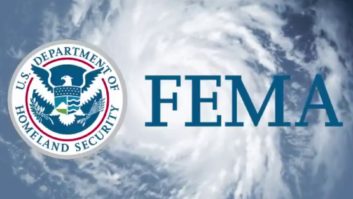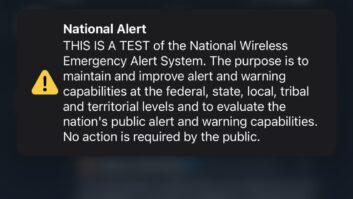There’s much to be gleaned from the two newly released governmental reports about the September nationwide EAS test.
While the Federal Communications Commission report we told you about a few days ago was heavy on stats and reporting minutiae (including the nugget that radio participants had an average 87.3 percent participation rate in submitting their EAS test results when compared to their television brethren), a companion report from FEMA included insightful details on the way the test kicked off, the reason some messages were not received and some specific recommendations for the future.
Based upon observations during previous regional testing efforts, FEMA said in its report that EAS test observations and reports fell within expected norms, though there are a number areas for improved performance.
After the September test, broadcasters were required to submit data about it to the FCC EAS Test Reporting System. Some 16,900 broadcaster EAS participants responded, as well as nearly 3,300 cable operators. A whopping 95 percent of full-power stations (both radio and TV) received the EAS message, with the number of LPFM stations a bit lower (87 percent).
Data on low-power FM broadcast was presented separately, FEMA said; providing outreach to the LPFM broadcast community has been challenging because these licensees are independent and not generally represented by associations.
FEMA also looked at the raw ETRS data when it came to determining why stations failed to receive the test.
Issues included problems with configuration and equipment failure, as well as obsolete gear and wiring troubles. The top reason reported was no discernible reason at all: 27 percent of “fails” had no reason given. The second biggest — that of configuration — was 20 percent. Six problems were tied for last place (at .05 percent) including the fact that for one station, its EAS box had been stolen.
Perhaps the most adorable of all explanations: An owl’s nest obstructed the transmission, one FM station said. (According to FEMA, the exact relationship between the owl’s nest and the EAS message remains unknown.)
The FEMA report also detailed problems with sources; it suggested that some stations’ EAS monitoring assignments would likely benefit from review by their State Emergency Communications Committees. Source failures included the inability to receive assigned monitor stations, and cases where the monitored stations did not relay the test message successfully.
The report also offered clues through case studies, such as a situation in Philadelphia. Stations there reported receiving the NPT followed by some stations’ normal talk programming with no End Of Message (EOM). In Philadelphia, K‐Love station WKVP(FM) serves as a monitor source for the Local Primary station WHYY(FM). When WHYY’s EAS device received the double header NPT message from WKVP, the WHYY EAS device failed and returned to normal programming without originating an EOM.
As a result, the report said, a number of Philadelphia area stations carried up to two minutes of WHYY’s programming in lieu of the NPT audio message.
“It would probably be better in a perfect world if [K-Love’s] EAS interrupt was placed at a point in [its] air chain which was after the feed to its network of simulcast stations,” wrote Philadelphia engineer Larry Paulausky in the report.
FEMA said that this case, and others in St. Louis and Hawaii, illustrates what can occur when a secondary, unanticipated or corrupted EAS distribution system is in service.
“Additional work must be done to coordinate currently unanticipated EAS message delivery paths and to work with EAS device manufacturers to gain a better understanding of how specific devices process malformed and/or truncated EAS messages which appear to contain double data header packages,” the report states.
FEMA said state and regional EAS distribution networks must be exercised and examined regularly to ensure network integrity and to avoid delivery of garbled or distorted messages.
Looking ahead, the report states that performance can be improved — particularly if EAS participants give further attention to device maintenance and configuration.
The agency’s specific recommendations include promoting EAS awareness and conducting additional rounds of tests. FEMA also said it is encouraging the FCC to shorten the ETRS response deadline so a more timely analysis can be performed.










